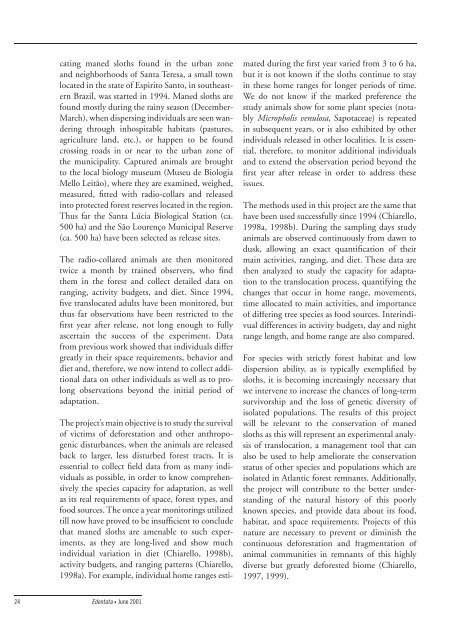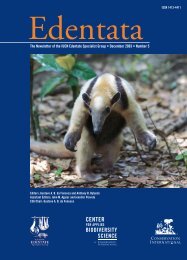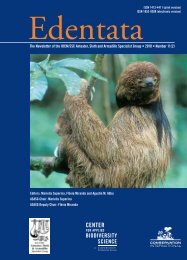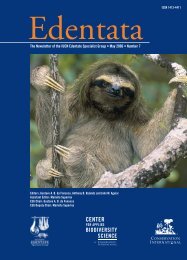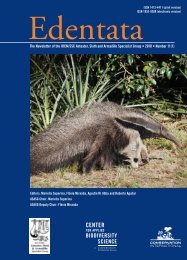Edentata 4 - Anteater, Sloth & Armadillo Specialist Group
Edentata 4 - Anteater, Sloth & Armadillo Specialist Group
Edentata 4 - Anteater, Sloth & Armadillo Specialist Group
You also want an ePaper? Increase the reach of your titles
YUMPU automatically turns print PDFs into web optimized ePapers that Google loves.
cating maned sloths found in the urban zone<br />
and neighborhoods of Santa Teresa, a small town<br />
located in the state of Espirito Santo, in southeastern<br />
Brazil, was started in 1994. Maned sloths are<br />
found mostly during the rainy season (December-<br />
March), when dispersing individuals are seen wandering<br />
through inhospitable habitats (pastures,<br />
agriculture land, etc.), or happen to be found<br />
crossing roads in or near to the urban zone of<br />
the municipality. Captured animals are brought<br />
to the local biology museum (Museu de Biologia<br />
Mello Leitão), where they are examined, weighed,<br />
measured, fitted with radio-collars and released<br />
into protected forest reserves located in the region.<br />
Thus far the Santa Lúcia Biological Station (ca.<br />
500 ha) and the São Lourenço Municipal Reserve<br />
(ca. 500 ha) have been selected as release sites.<br />
The radio-collared animals are then monitored<br />
twice a month by trained observers, who find<br />
them in the forest and collect detailed data on<br />
ranging, activity budgets, and diet. Since 1994,<br />
five translocated adults have been monitored, but<br />
thus far observations have been restricted to the<br />
first year after release, not long enough to fully<br />
ascertain the success of the experiment. Data<br />
from previous work showed that individuals differ<br />
greatly in their space requirements, behavior and<br />
diet and, therefore, we now intend to collect additional<br />
data on other individuals as well as to prolong<br />
observations beyond the initial period of<br />
adaptation.<br />
The project’s main objective is to study the survival<br />
of victims of deforestation and other anthropogenic<br />
disturbances, when the animals are released<br />
back to larger, less disturbed forest tracts. It is<br />
essential to collect field data from as many individuals<br />
as possible, in order to know comprehensively<br />
the species capacity for adaptation, as well<br />
as its real requirements of space, forest types, and<br />
food sources. The once a year monitorings utilized<br />
till now have proved to be insufficient to conclude<br />
that maned sloths are amenable to such experiments,<br />
as they are long-lived and show much<br />
individual variation in diet (Chiarello, 1998b),<br />
activity budgets, and ranging patterns (Chiarello,<br />
1998a). For example, individual home ranges estimated<br />
during the first year varied from 3 to 6 ha,<br />
but it is not known if the sloths continue to stay<br />
in these home ranges for longer periods of time.<br />
We do not know if the marked preference the<br />
study animals show for some plant species (notably<br />
Micropholis venulosa, Sapotaceae) is repeated<br />
in subsequent years, or is also exhibited by other<br />
individuals released in other localities. It is essential,<br />
therefore, to monitor additional individuals<br />
and to extend the observation period beyond the<br />
first year after release in order to address these<br />
issues.<br />
The methods used in this project are the same that<br />
have been used successfully since 1994 (Chiarello,<br />
1998a, 1998b). During the sampling days study<br />
animals are observed continuously from dawn to<br />
dusk, allowing an exact quantification of their<br />
main activities, ranging, and diet. These data are<br />
then analyzed to study the capacity for adaptation<br />
to the translocation process, quantifying the<br />
changes that occur in home range, movements,<br />
time allocated to main activities, and importance<br />
of differing tree species as food sources. Interindivual<br />
differences in activity budgets, day and night<br />
range length, and home range are also compared.<br />
For species with strictly forest habitat and low<br />
dispersion ability, as is typically exemplified by<br />
sloths, it is becoming increasingly necessary that<br />
we intervene to increase the chances of long-term<br />
survivorship and the loss of genetic diversity of<br />
isolated populations. The results of this project<br />
will be relevant to the conservation of maned<br />
sloths as this will represent an experimental analysis<br />
of translocation, a management tool that can<br />
also be used to help ameliorate the conservation<br />
status of other species and populations which are<br />
isolated in Atlantic forest remnants. Additionally,<br />
the project will contribute to the better understanding<br />
of the natural history of this poorly<br />
known species, and provide data about its food,<br />
habitat, and space requirements. Projects of this<br />
nature are necessary to prevent or diminish the<br />
continuous deforestation and fragmentation of<br />
animal communities in remnants of this highly<br />
diverse but greatly deforested biome (Chiarello,<br />
1997, 1999).<br />
24<br />
<strong>Edentata</strong> • June 2001


